How To Create Small Business Goals Like Tech Unicorns – Using OKR’s
The best small business operators are strong decisions makers. And one of the most important tools they use to make good decisions is goal setting.
Setting business goals helps you make decisions with clarity. They give you something to aim at. So you know when to say yes and when to say no because you can tie every decision back to your target.
Over the past five years, I’ve tried several different goal-setting methods across various businesses, and OKRs are by far and away the most effective framework I’ve used.
In this guide, I’ll explain what OKR’s are, why they work, how I write them and how to apply them to your business.
What Are OKR’s (Small Business Goal Setting Framework)
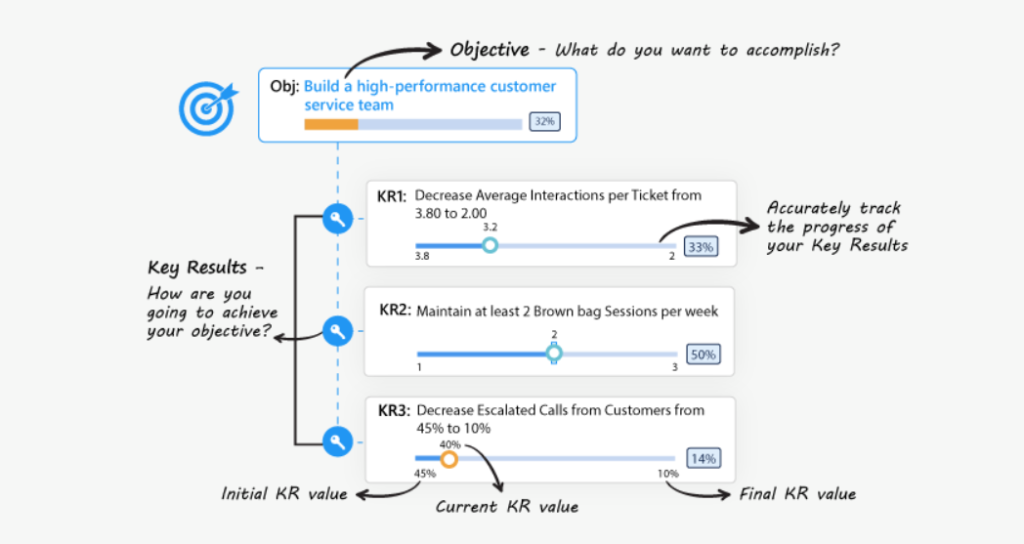
– Thanks to profit.co for this infographic.
Andy Grove, Founder and CEO of Intel, developed and started using OKRs in the ’70s. After being made popular by John Doer’s book, measure what matters. They’re now used by the world’s most successful companies, like Spotify, Twitter, Netflix, Amazon, Google, and more.
OKR is an acronym for – Objective + Key Result.
The objective is a description of an achievement you’d like to reach in the future. Like ‘build a high-performance customer service team’. And the key results are measurable outcomes you can use to track your progress towards that objective. Like ‘decrease average interactions per customer support ticket from 3.80 to 2.00’.
Besides helping you make better decisions. OKRs will align your team, provide clear direction, increase focus, increase transparency, and force commitment.
How To Write OKR’s
Your OKRs should help you answer two critical questions about your business.
1. What do you want to achieve – Your Objective
2. How will you know when I’ve achieved it – Your Key Results
As I mentioned earlier, your objective should be descriptive rather than based on numbers and an outcome that means something to you and your team. Like, becoming ‘becoming your cities goto burger bar’ or ‘creating the world’s most comfortable running shoe’. They’re goals that are both relatable and aspirational.
• I also like to ‘back up’ my objectives with two to three sentences describing why I want to achieve that objective. The why might be obvious to you now but is easy to forget. You’ll thank me when you need to re-explain them to your team in a month.
Key results are specific, measurable, time-bound and verifiable. They should help you measure your progress towards your objective. For example, ‘Become the highest-rated running shoe on XZY platform by March 31st’.
• I’ve found setting three key results per objective works best. And I prefer to use one lead indicator and two output indicators per objective. Actions (inputs) don’t necessarily lead to results (outputs), and results aren’t always the best measure of progress.
A lead indicator measures inputs. Like ‘cold call 100 CEOs by the end of the quarter’.
A lag indicator measures outputs, like ‘sell $1,000,000 worth of product by the end of the quarter’.
• Here’s my OKR for Q1, 2022, at World Fitness (We’re using Clickup)
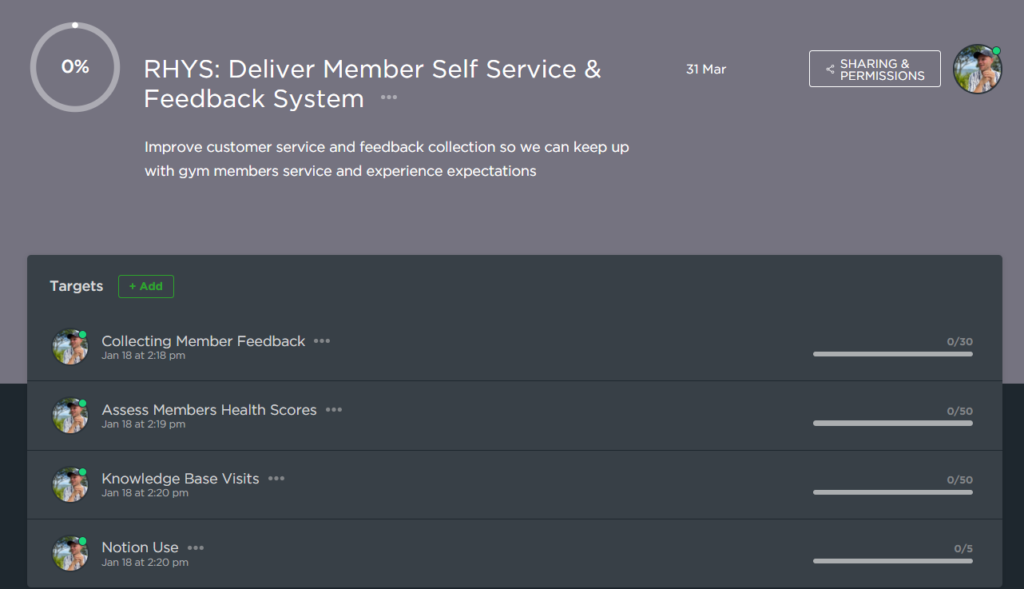
• When you achieve an OKR, it should be noticeable both internally by your team and externally by your customers.
Creating OKRs For Different Periods Of Time
OKRs can be applied to all organisational levels and across different periods, making them useful for setting small business goals. As your business and time horizon grows, they can grow with you.
Let me explain further.
Long-term goals can cascade down to short-term goals. I use OKRs to set long-term goals and then set shorter-term goals based on those long-term goals.
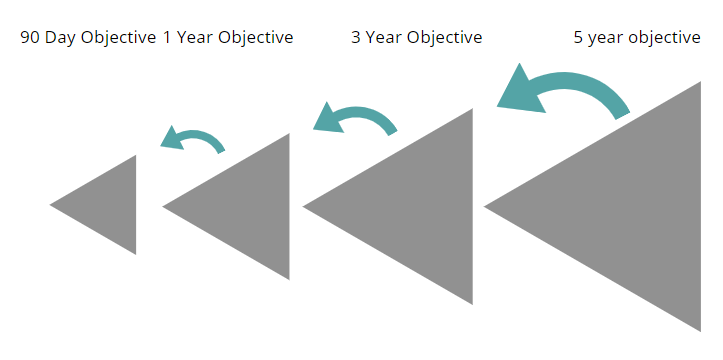
So a 5-year goal informs your 3-year goals, which informs your 1-year goal and so on. Achieving big goals is easier when you break them down into smaller ones.
Creating Small Business Goals With OKRs Across Different Periods
Let’s use my gym as an example.
My business partners and I have other things we’d like to do with our lives. We’ve been building our gym for almost five years now, and we’re thinking about moving on. But we’ve got to sell the business first.
So our long-term (5-year) OKR is ‘selling the gym’.
Objective: Prepare the business for sale due to burnout
Key Result 1: Sell business by xx/xx/xx date
Key Result 2: Sell business for $x,xxx,xxx
Key Result 3: Increase profitability to $xxx, xxx
We can use that 5-year goal to set a 3-year goal like ‘becoming a profitable community-driven gym that helps its people achieve their health and fitness goals. And hitting the 3-year goal will hopefully help us reach our 5-year goal.
The further you zoom in from your high-level goals down to your one year or three-month goals, the more detail you have available to make more informed decisions.
For example, the lease contract for our Eftpos Machine just expired. Deciding whether we should re-sign with our current provider or look at other options is hard to do when using a five-year objective. But easy when using a quarterly goal.
Because our EFTPOS machine lease will have a <1% effect on our five-year goal but could have a >5% effect on a 90-day objective. For example, say our short-term goal is to increase retail sales – then whether that EFTPOS machine has paywave or not matters.
So cascading goals for our gym might look like this:
5 year
Objective = Sell the gym
• KR 1 = $xx of dollars sale price
• KR 2 = Sell by xx/xx date
• KR 3 = Profitability of $xx
3 year
Objective = A profitable community-driven gym that helps its people achieve their health and fitness goals
• KR 1 = Profitability of $xx
• KR 2 = X number of Community-driven decisions
• KR 3 = X number of Member goals achieved
1 year
Objective = Build a self-managed gym
• KR 1 = Hire gym manager
• KR 2 = Reduce mine and business partners’ work hours to 20 per week
• KR 3 = Increase revenue to $xx
90 day
Objective = Create management position
• KR 1 = Create gym management job description
• KR 2 = Interview 5 position candidates
Creating Small Business Goals Across Teams And Business Units
As I mentioned, OKRs also flow between organisational levels and business units.
You can set a company OKR and then pass that onto your managers to set department OKR’s who can give them to their teams to set individual OKR’s and so on. They can adapt to your company’s size and structure.
My gym is small (7 staff) so we have a simple organisational chart. I set one company goal and pass that onto my team to set department goals.
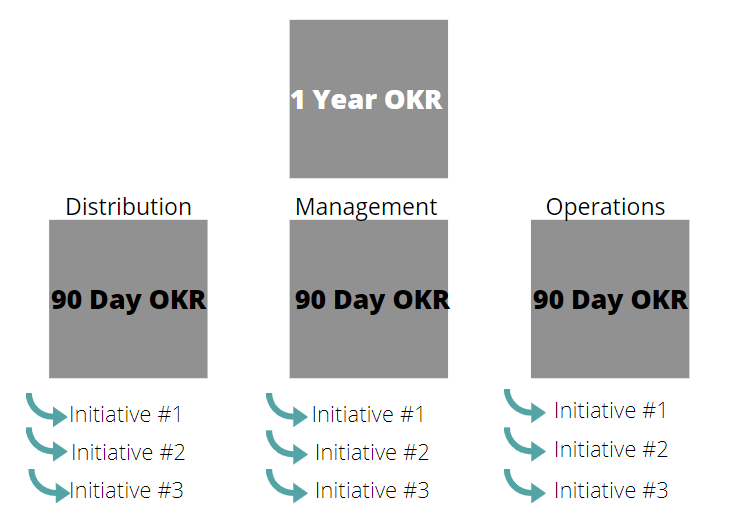
Once we’ve agreed on our OKRs, I make sure the responsibility for each OKR is clear. In my experience, there should only ever be one person responsible for each OKR. When accountability isn’t clear, goals get missed.
Our gym has three departments, Distribution, Management and Operations. As the business manager, I’m responsible for the company objective, and my team are responsible for their department objectives.
• Setting one OKR for each person, company, or business unit works best. Multiple OKRs causes confusion, which leads to a lack of focus and low progress. The simpler, the better.
Review And Reflect On Your OKR’s
“The wise man doesn’t give the right answers; he poses the right questions” – Claude Levi-Strauss.
Each time you complete your small business goals cycle, say quarterly, you want to improve. You’ll learn a lot by putting this method into practice. It’s taken me ~18 months to get comfortable and reasonably good at it.
You’ll never set the perfect goal; each error is an opportunity to get better. Which is why I think a review and reflection process is helpful.
So I created a template that helps me and my team reflect on our goals and find insights we can use to improve our goal-setting process each iteration.
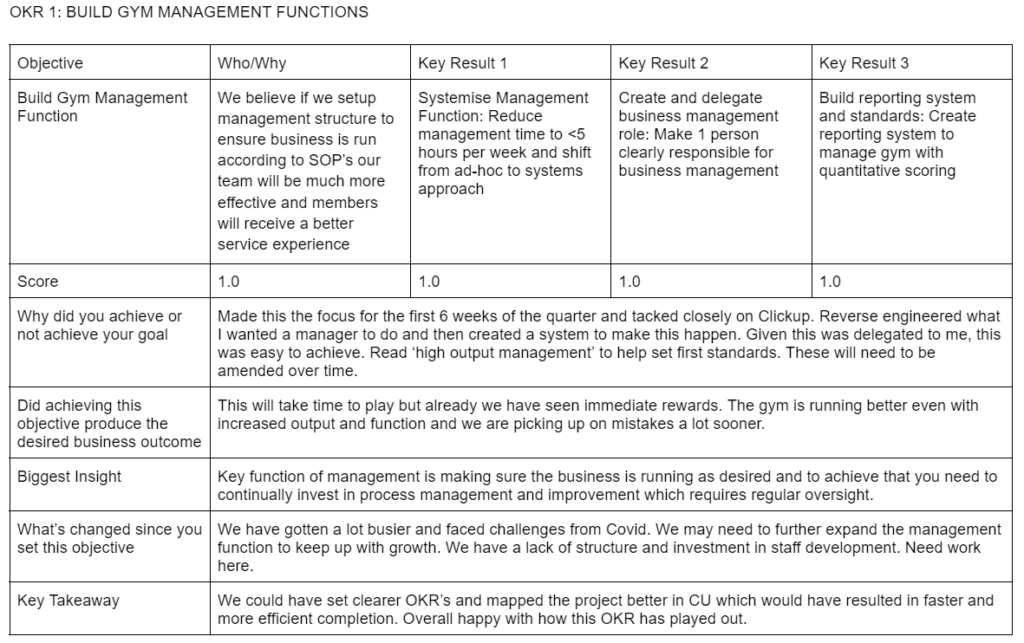
I score each key result on a scale of 0 – 1.0. When you set quantitative key-results, this is easy to do. If you’ve not used a metric for your key results, estimate your score.
Then I work my way through each question for the OKR. I reflect on the objective as a whole – not the key results. As the objective is the outcome, we’re aiming for not individual key-results.
Carry these insights into your next goal-setting session, and you’ll keep setting better goals, leading to better business outcomes.
OKR’S ARE SIMPLE BUT NOT EASY
Goal setting is most effective when you repeat on a recurring basis. And learn from the previous period each time you go through that process.
Following the OKR framework for goal setting is simple but deceptively tricky to do well. You’ll set objectives that you realise didn’t really mean anything for your business. Or you’ll set key-results that are misleading and poor indicators of progress. Don’t stress; it’s part of the process.
I’m writing about using OKRs now after trialling them for the better part of 2 years. It’s taken me eight quarters of iteration to refine my approach to get good at using this system.
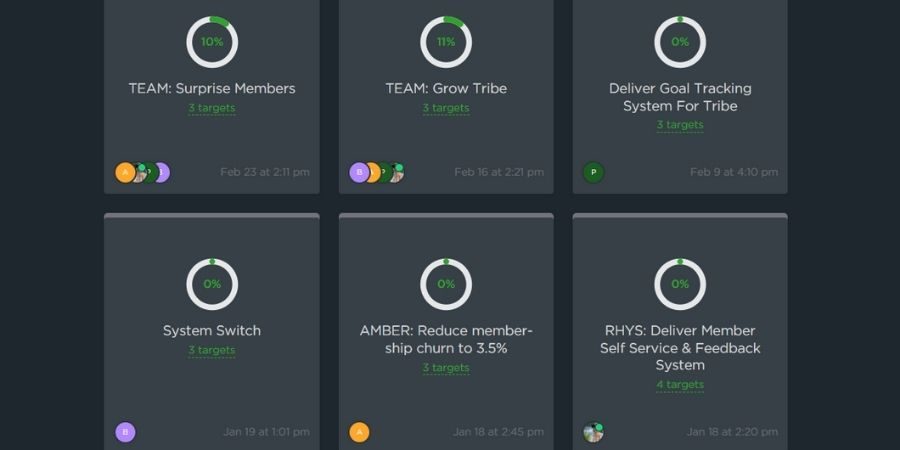


Comments: 2
Pingbacks and Tracebacks
[…] I use OKRs to set my goals. […]
[…] now that we agree, this responsibility lies with you (and perhaps you even make this a quarterly goal). Let’s move on to what you should […]